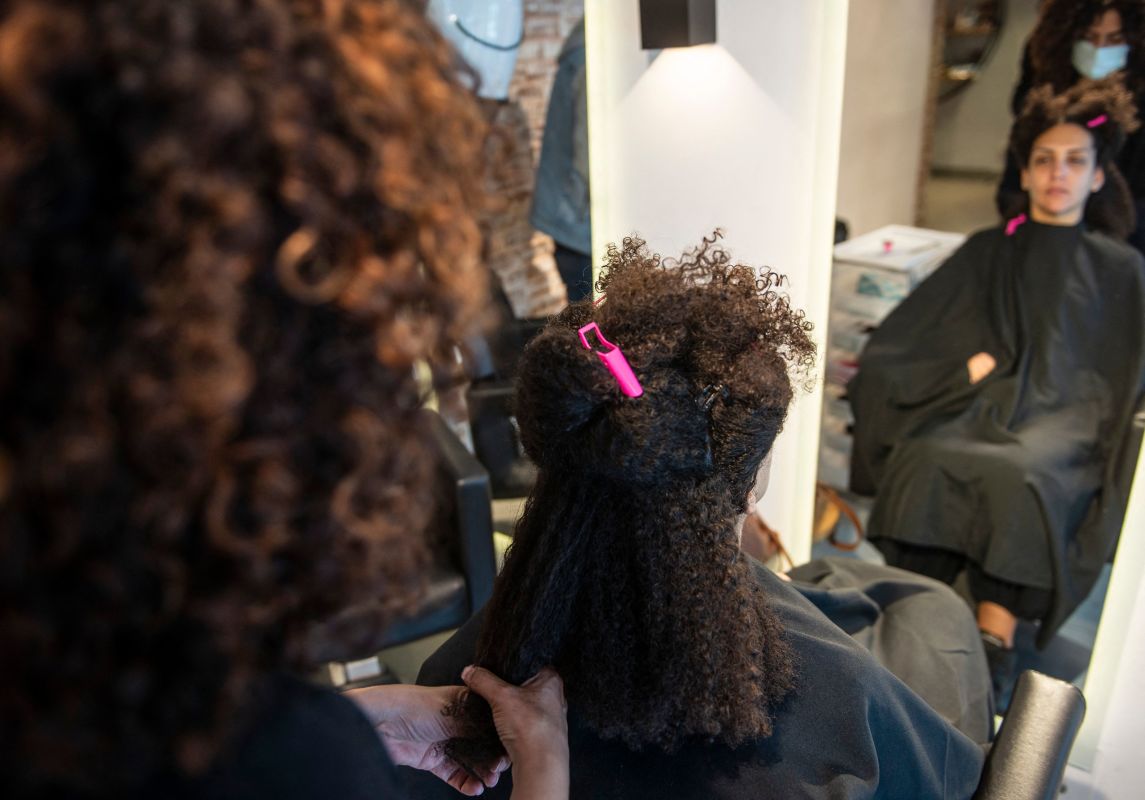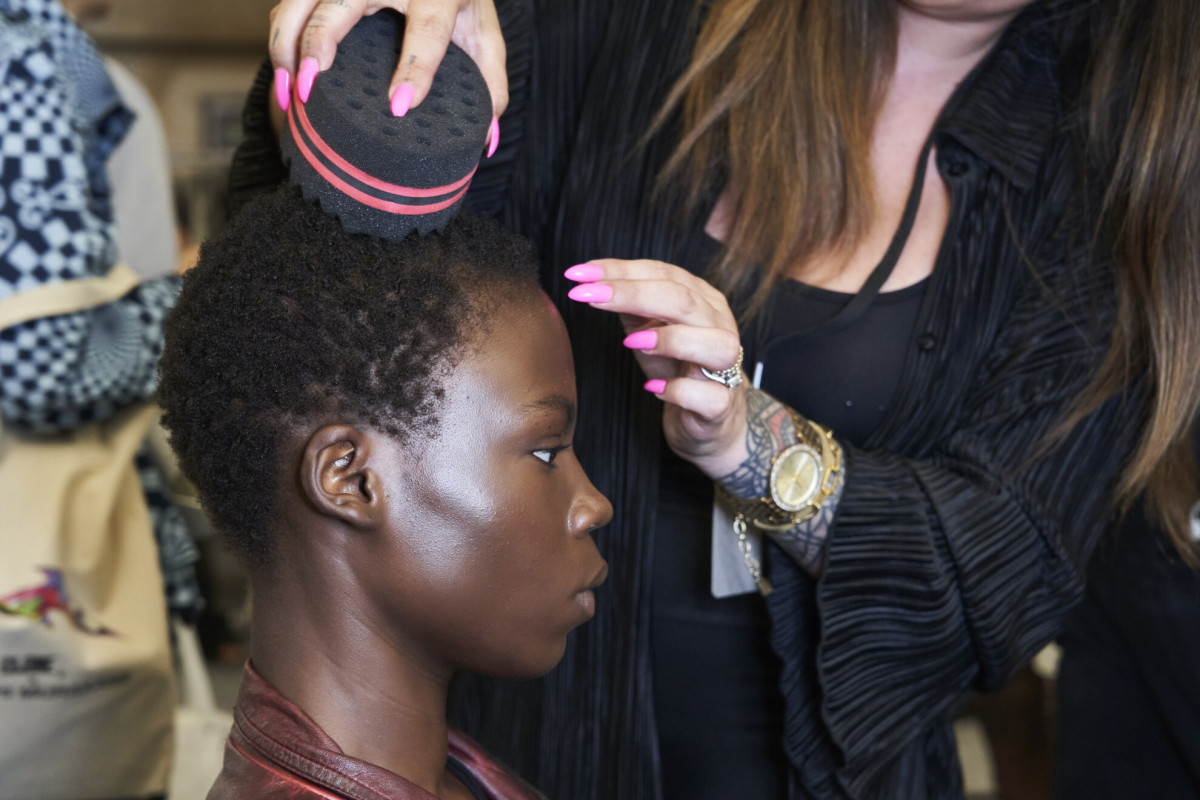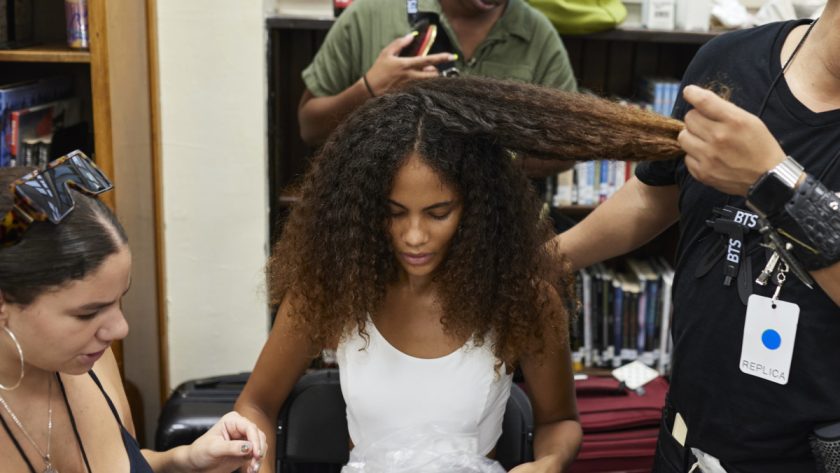Bias against curly and coily natural hair textures is among the most documented and pervasive current forms of race-based discrimination in the United States. While it’s common in professional sports, schools, the workplace and general daily life for many, one area in which it’s also felt deeply is the American salon industry. While many stylists and salons themselves fall short when it comes to adequate textured hair training, the root of the issue also lies in the fact that the subject has historically been systemically excluded from cosmetology education.
That may be set to change — at least in New York state.
On Nov. 17, Governor Kathy Hochul officially signed New York Senate Bill S6528A into law. Originally introduced in April of this year, the legislation aims to equip hairstylists — regardless of their own race or ethnicity — to work with all hair types by requiring cosmetology exams to include textured hair education in testing and, thus, schools to include it in their curriculum.
For Black folks, who often make up the majority of curly and coily salon clientele, this step has the potential to help equalize styling access and spur major change.
“Many people are excited about the prospect that every cosmetologist is going to have to familiarize themself with textured hair and understand textured hair,” New York Assemblywoman Michaelle C. Solages, a vocal supporter of the bill, tells Fashionista. “We’re building on the fact that we want to promote diversity, inclusion and empowerment. Someone with textured hair should receive the attention and expertise that they deserve in the cosmetology field.”
Ahead, experts – including celebrity hairstylists, beauty editors, cosmetology school representatives and legislators — unpack the potential impact of New York’s Bill S6528A, reflecting on what it took to get it passed and discussing what it may mean for other states and the future of American cosmetology education as a whole.
Photo: Launchmetrics Spotlight
What Does New York Senate Bill S6528A Accomplish?
As the legislation states, the “bill would require cosmetologists and natural hairstylists to, pursuant to regulations promulgated by the secretary of state, complete certain training, as well as include questions on license examinations, regarding the provision of services to individuals with all hair types — including, but not limited to, various curl and wave patterns, hair strand thicknesses, and volumes of hair — as a condition of licensure.”
For Adjoa B. Asamoah, co-founder and lead strategist of The CROWN Act, this naturally complements advocating against overt race-based hair discrimination: “It’s not always just the explicit outright blatant discrimination that’s racial, but also the part that needs to be lifted is that lack of education,” she says.
Why Is This Type of Legislation Necessary?
These changes have the potential to eliminate a double standard, wherein Black stylists are often adept at working with all hair types — despite also frequently being paid less — while stylists with naturally straight hair are neither expected nor required to have skill sets that apply outside their own texture.
Hairstylist Nai’vasha, who has worked with celebrities like Tracee Ellis Ross, Yara Shahidi and Lupita Nyong’o, recalls clearly how textured hair was very much an afterthought in her own cosmetologist education. Students who wanted to acquire those skills had to seek them out independently, she says.
“I went to Paul Mitchell The School in Atlanta, and there were no texture conversations happening in the classroom. If you wanted to know anything about textured hair, which is maybe a good 80% of the student body, it had to be after graduation, versus a requirement to graduate,” she says.
In her opinion, this type of education is crucial: “When you talk about color, when you talk about chemically treated hair, when you talk about curling hair, straightening hair, anything that requires heat, all the way down to our shampooing and how to detangle different textures… that should automatically be a part of the conversation and a part of the educational journey, because all textures matter. All textures deserve to be handled and treated and cared for by the professionals in a way that is best suited for the clients.”
Nai’vasha’s experience rings true for hairstylist Cynthia Alvarez, who works with brands like Biolage and has counted Shakira and Maluma as clients. She remembers choosing to learn about textured hair styling with her classmates “on our own time” back in 2006.
The ability to work with all hair textures is crucial to being a successful hairstylist, she says. “The goal is to have your model or your client leave your chair happy and feel like they spent their money on someone that was really worth it, someone that made them feel confident. You want people to feel good. Not some people — but all people.”
While some individual cosmetology schools and corporate entities have taken it upon themselves to attempt to correct for the omission of textured hair education as required by law, it’s become increasingly clear that legislation is likely the most impactful course of action when it comes to bringing about widespread, lasting change.
Photo: PYMCA/Avalon/Getty Images
While people of any ethnicity can of course have curly, coily and textured hair, it’s most common (and most commonly discriminated against) in Black folks. There’s a long history in the United States related to the subjection of Black hair, dating back to slavery, continuing through eras of segregation and extending to today, where discrimination and sentiments still linger about “acceptable” ways for Black hair to exist.
“There is no part about being a Black person and existing in a Black body that comes with ease,” says Kayla Greaves, a beauty editor and industry expert who recently reported on Bill S6528A for Allure. “Nothing in this world. Everything around us makes us feel like we’re an inconvenience, or we have to do some form of extra labor in order to receive adequate service, which half the time we’re not even going to get,” she continues, underscoring the research and vetting that salon clients with textured hair are often forced to conduct themselves when seeking out a new salon or stylist.
It’s an all-too-common experience, she says, to encounter hairstylists in her home of New York City that aren’t equipped with the proper training to cater to her hair’s needs. “I always ask, can they work with 4C type hair? I need to know that they can literally work with the loosest waves to the tightest coils, or I’m not going there.”
And that’s to say nothing of the fact that salons frequently charge more for curly and coily services, only adding to the very real extra cost of simply existing while Black.
Photo: Mohamed Hossam/Getty Images
Who Got the Bill Passed?
Bill S6528A was first introduced by New York State Senator Jamaal T. Bailey in April 2023, and then carried through by Assemblywoman Solages. Most recently, it was signed into law by Gov. Hochul.
“As a legislator, ultimately you want to pass laws that improve people’s lives, whether that’s by keeping them safer or creating new regulations. But a lot of that has to come through someone who has had a problem or has experienced a concern,” Bailey tells Fashionista. Through his constituents, wife, daughters and own lived experience, he personally knows what it’s like to be turned away from a salon or receive inadequate care because of natural hair texture.
“When you have culturally competent leadership that understands certain things, that they know that this isn’t people crying wolf. This isn’t people saying that we need the CROWN Act because this discrimination is just kind of happening. They know that it is happening,” he adds.
How Will Cosmetology Schools Adapt?
From Nov. 17, cosmetology schools in New York have six months to change their curriculum in order to make sure their students can pass the soon-to-be updated exams for licensure. This buffer time, Aveda Arts & Sciences Institutes CEO Edwin Neill says, gives time to schools to make the necessary changes.
The task, he emphasizes, is a reasonable and manageable one. “The curriculum is out there. The main curriculum providers have textured hair curriculum available,” he explains. “What needs to be revamped is what you’re doing during the students’ time in school. So it’s really a question of reworking the schedule. As far as for people who know textured hair, those instructors are out there, and a lot of instructors in the school and beauty schools already know how to do textured hair.”
Is This Part of The CROWN Act?
While Bill S6528A is not officially related to The CROWN Act, its goals are very much aligned. And they’re both part of spurring conversations and meaningful change when it comes to hair inclusivity.
For Nai’vasha, the two pieces of legislation are obviously and inextricably linked: “If there wasn’t The CROWN Act, there would not be this bill that was passed. The CROWN Act walked so this bill could run.”
Who Is Supporting It?
A variety of advocacy groups are celebrating that Bill S6528A passed and are continuing to advocate for similar bills in other states. See: the Textured Education Collective (founding members include L’Oréal, Aveda, DevaCurl and Neill), The Natural Hair Industry Convention, Black Beauty Roster, The Natural Hairstyle and Braid Coalition and more.
Photo: Launchmetrics Spotlight
How Could This Impact the Fashion Industry?
With the legislation taking place in New York specifically, there are a number of important implications that may resonate in the fashion industry. The dearth of textured hair education has meant that many Black models’ backstage experiences at New York Fashion Week have included hair-related horror stories. It’s also why many Black models end up having to wear very short hair on the runway and in editorial shoots. And despite the existence of plenty of hairstylists who do know how to work with textured hair, they’re (rather paradoxically) not hired as readily.
The new legislation may underscore and validate the importance of textured hairstyling skills, eventually not just equipping stylists with the proper training, but also shining a light on its importance for other industry stakeholders.
Beyond hair professionals specifically, it’s crucial for other creative collaborators, agents and decision makers involved in runway or editorial projects to be better informed about the realities of working with textured hair.
“I’ve been asked, ‘Can we put a wig on top of another wig?’ by a major production company that’s doing a huge campaign for major brand,” Jay Lopez, an agency director at WME, tells Fashionista. Lack of textured hair education and understanding extends far beyond stylists themselves. So the hope is that through legislation — and conversations about said legislation — there will be an overall increase in awareness and inclusion.
Broader Implications and Looking Ahead
Louisiana passed its own similar legislation in 2021. New Jersey is also expected to pass a bill amplifying textured hair inclusion in education. Lopez acknowledges it’ll “take a while before change really takes full effect,” but this bill still means, at the very least, that the next generation of hairstylists in New York will better understand how to care for all hair textures.
“I’m excited. I’m hopeful,” says Nai’vasha says. “That bill being passed… just lets me know that we’re getting a little bit closer (to making progress).”
“As we get stylists now who are graduating from school, entering salons and can do any type of hair, we’re going to see the salons change, too. I think we’re going to see less of that sort of racial divide in salons,” says Neill.
The hope is that the bill will contribute to a ripple effect in other states, encouraging more legislatures to take similar action surrounding cosmetology eduction.
“We’ve already had conversations with about eight different states about implementing textured hair testing in their states. We don’t get pushback, really. That’s the crazy thing. The barrier is institutional inertia. It’s not a question of red states and blue states,” Neill notes. “People are in favor of it, and it’s just a question of getting it done.”
For the bills like this to pass in other states, Asamoah notes, it’ll take more engagement and more of a concerted effort: “I think in order for something like this to become a nationwide movement… really being strategic (is important).”
Ultimately, Bill S6528A is an important step in a long road toward progress. For those who have struggled with discrimination in salons, there is new hope for the future. And this legislation also works against centuries of trauma surrounding the exclusion of Black hair.
“Personal care is not vanity. It means that you’re interested in taking care of yourself. That’s important. There’s a link between mental health and these conversations. That’s a sense of def facto therapy when you’re in these spaces and places. It’s not vanity. It’s necessity,” says Bailey.
Want the latest fashion industry news first? Sign up for our daily newsletter.



